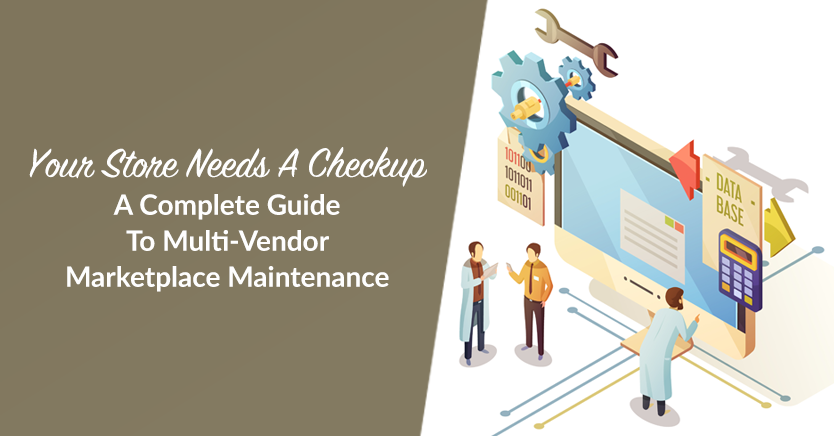
Successful websites run smoothly and efficiently while keeping customer data secure. Ensuring that your online marketplace operates in this manner will positively affect your customers and vendors. This is where multi-vendor marketplace maintenance comes in.
Regular marketplace checkups are especially crucial considering that consumers increasingly expect positive experiences in their online shopping. Not to mention that they don’t have much patience for anything else, which explains why 91% of customers don’t return to a store after a single bad experience.
Fortunately, proper marketplace maintenance can provide great experiences by maximizing efficiency, dependency, and predictability, thus enabling you to give your customers precisely what they want, when they want it. And the better your website functions, the happier your customers will be.
Because a smoothly operating website is critical for success, we’ve put together a brief but thorough guide to help you master your multi-vendor marketplace maintenance. So let’s get right to it!
Marketplace Maintenance: Technological Considerations
Proper marketplace maintenance happens in two distinct areas. First, you need to ensure that the backend pieces of your technology work. This will help your site perform well on every level.
We’ll cover these issues first before delving into optimizing your site for better experiences.
1. Software Updates
Software updates in WordPress bring in features and fix issues to help improve experiences for your users. Research indicates that hacking incidents in WordPress sites usually happen due to outdated versions. Thus, getting your updates in order is key to keeping things moving properly.
Agreeing to automatic updates helps you have one less thing to worry about as the site will update on its own without you having to go through the process each time. In addition, it ensures that you always have the most recent update installed on your site.

2. Security Checks
Running an online store requires a bit of risk. Malware and other potential security threats loom across the internet, looking for opportunities to attack.
If your marketplace’s data falls victim to such security threats, rebuilding trust with customers can be challenging.
Making frequent security scans part of your work routine will catch threats early and help you avoid any big emergencies. You can also take preventive measures by:
- Working with a high-quality hosting site
- Partnering with an excellent security scanning software platform
- Monitoring reports or suspicious activity on your site
3. Backup Performance and Restoration
Backups copy all the data on your website and set them aside if the site gets shut down. This usually relates to security threats and data breaches, but other factors could cause the problem, too.
A site backup should adhere to the following criteria:
- Regular Updates: Updates should be performed each time your site undergoes changes.
- Comprehensive: Backups should include all pertinent site data.
- Secure: The storage location of the backup data should be separate from your website’s server.
- Accessibility: Backup data should be easily accessible for swift retrieval and restoration.
Furthermore, it’s good practice to test the restored data to make sure your backup process works correctly. After all, it doesn’t do you much good to have backups that don’t work. Restoring the files every once in a while will help you test their accuracy.

4. Features Audit
The more features you have, the more bandwidth your site takes up. This can affect loading speed and usability, making it difficult for customers to navigate your marketplace.
While you do need features to help your site function, we’ve seen a lot of marketplaces add so many features that they end up damaging the site and the user experience.
Running a features audit will help you identify which features help and which ones harm your marketplace as a whole. Once you identify the ones you don’t use, you can remove them and free up space for your site to perform better.
5. Site Speed Testing
Speaking of speed, the modern consumer doesn’t have much patience for a slow marketplace. Most of us are so used to fast-loading websites that we click away if we can’t quickly get to the page we want.
Adding site speed tests to your marketplace maintenance will help you flag problem areas like demanding plugins or large files on the site. You can work with third-party providers and services that specialize in this area to get the best results.

Marketplace Maintenance: The Customer Experience Angle
Getting your backend maintenance down helps you avoid problems on your site, but that’s only half the problem.
A successful online marketplace also makes it easy for your customers to navigate your site and find what they’re looking for.
One way to do this is by putting yourself in the customers’ shoes. Basically, you should go through the processes and journeys that you want them to experience and see how well they operate.
Here are four processes to monitor and maintain to create great customer experiences.
1. Refunds and Returns
Nearly 50% of customers return products to online stores. Negative experiences involving returns can cause cart abandonment and non-purchases. Therefore, getting refunds and returns right can help any marketplace business succeed.
Managing returns comes down to clarity, speed, and efficiency:
- Spell out your refund policy clearly and make it available for customers to access.
- Handle returns and refunds in a timely manner. This way, customers won’t need to wait long for their refunds or replacements to be processed and delivered.
- Make it easy for customers to return their products.
Your refunds and returns can function like a service that you offer to your buyers. They’ll recognize and value the effort you invest in managing these aspects effectively.
2. Marketing Content
Paid ads, blogs, landing pages, and other promotional material can be a great way to grow your online marketplace.
When marketing techniques work well, they send shoppers through a funnel, guiding them to the next step of engagement until a purchase is made.
You can test these funnels by sending yourself or a team member through each step to see how it feels. Does the copy on a paid ad make you want to click it? Does the landing page invite you to a clear next step? Are the blogs interesting?
These kinds of questions can help you identify how effective your marketing content really is.

3. Checkout Processes
There’s a reason Amazon has a one-click buying option: efficiency sells.
Checkout processes don’t need to be complicated. If a customer has gone through all the steps to make a purchase, your marketplace should make it easy for them to get over that final hill.
Here are a few things to look at when evaluating your checkout process:
- The number of clicks needed to arrive at the order confirmation screen
- The checkout process of someone with an account versus someone who needs to create one (Bonus Tip: guest checkouts actually help your sales go up)
- Payment gateway functionality
- Any post-purchase email flows
4. Email Subscriptions
Effective email marketing brings all sorts of benefits:
- Continued customer connection
- Opportunities to upsell and/or cross-sell
- Audience segmentation
- Targeting for marketing campaigns
Most marketplace websites have plenty of opportunities for customers to subscribe to an email list, so it’s important to make sure those buttons actually offer what they say they do.
We’ve noticed that people often take emails for granted. However, including them in your marketplace maintenance can help you catch those missed opportunities. Thus, go through your signup invitations occasionally and ensure that they’re connected with the email marketing service you use.

Conclusion
Testing your technology and user experience is key to making sure your multi-vendor marketplace works as intended. When customers have a great experience, they’re more likely to come back for more.
To recap, the technological side of marketplace maintenance involves:
- Software updates
- Security checks
- Backup performance and restoration
- Features audit
- Site speed testing
In addition, marketplace maintenance should incorporate customer experience. Thus, you must optimize your:
WC Vendors allows you to build multi-vendor marketplaces that are both technologically sound and customer-friendly. Our easy-to-use WordPress plugin has helped thousands of our customers launch, scale, and manage their marketplace businesses. We’d love to help you do the same.
Check out our product offerings page to learn more.